Lava Xolo X900 Review - The First Intel Medfield Phone
by Brian Klug on April 25, 2012 6:00 AM ESTCellular Performance
Cellular connectivity on the X900 is courtesy Intel’s Infineon acquisition, and uses the popular XMM6260 / X-Gold 626 baseband that we have seen in numerous other HSPA+ smartphones, including Galaxy S II and Galaxy Nexus, among others. Obviously Intel/Infineon knows how to implement its own baseband, and has done so in the device. The X900 is thus limited to GSM/UTMS for its air interfaces. The interesting part is that it’s another one of the pieces of the puzzle which Intel has in its portfolio for eventual inclusion in some upcoming SoC, and on the other hand is a major component built for an Intel phone not at an Intel fab, instead at TSMC on their 40nm process for baseband and 65nm CMOS for the UE2 transceiver, with an ARM11 at its core.
I mention these things since it’s one of the next areas that Intel will need to work on - both taping out its existing designs on its own 32nm or 22nm processes for manufacture at Intel fabs, and eventually making this another x86 powered device. Eventually baseband tasks will be de-elevated from something existing on essentially its own discrete SoC to just another task for a hypervisor to shuffle around on the main multicore SoC.
| Lava Xolo X900 - Network Support | |||||
| GSM/EDGE Support | 850 / 900 / 1800 / 1900 MHz | ||||
| WCDMA Support | 850 / 900 / 1900 / 2100 MHz | ||||
| Baseband Hardware | Intel/Infineon X-Gold 626 / SMARTi UE2 Transceiver | ||||
| HSPA Speeds | HSDPA 21.1 (Cat.14) / HSUPA 5.76 (Cat.6) - 3GPP Rel.7 | ||||
Anyhow back to the X900 - it’s a quad band WCDMA and GSM/EDGE device, with support for everything but AWS basically. That’s good enough for HSPA+ on almost everything except those on carriers who run AWS. X-Gold 626 supports 64QAM on the forward link, meaning HSDPA up to category 14 / 21.1 Mbps. The reverse link has basically stayed the same for a while now on WCDMA at category 6 / 5.76 Mbps. In addition the device supports 3GPP Release 7 features which makes it HSPA+. The X900 also implements WCDMA receive diversity.
I went ahead and ran just short of 100 tests using the trusty speedtest.net app on the X900 in my AT&T market which runs WCDMA on PCS 1900 MHz.
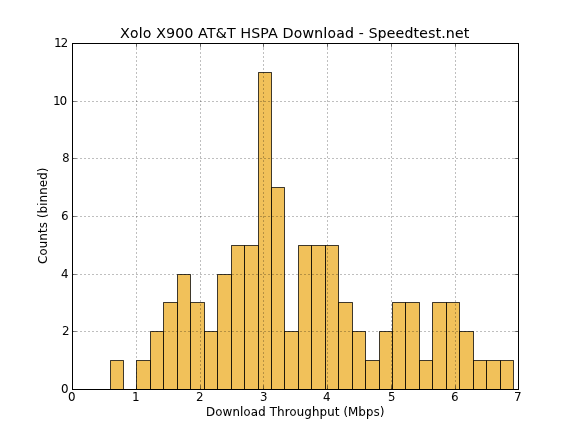
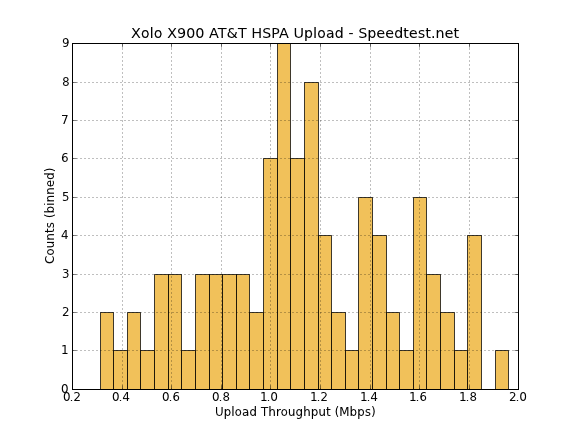
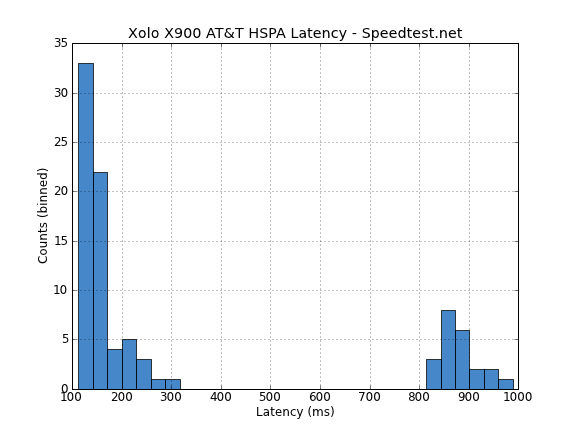
At this point HSPA+ 14.4 on AT&T is fairly well understood, running these is more validation that there’s nothing wrong with cellular on the device, and unsurprisingly there isn’t - again Intel knows how to implement its own baseband without issue, and with good performance.
WiFi
For WiFi and Bluetooth, the X900 uses a TI WiLink WL1271 series 6 combo chip which supplies 802.11b/g/n single spatial stream on 20 MHz channels with the short guard interval rate of 72 Mbps, and bluetooth 2.1 + EDR support. Some of the Intel documentation shows a TI WL1283 being used (which is WL 7.0 and includes a GPS baseband) and I don’t doubt that other Medfield platforms may implement WL128x or even WiLink 8 series with GNSS, however the X900 is definitely WL1271.
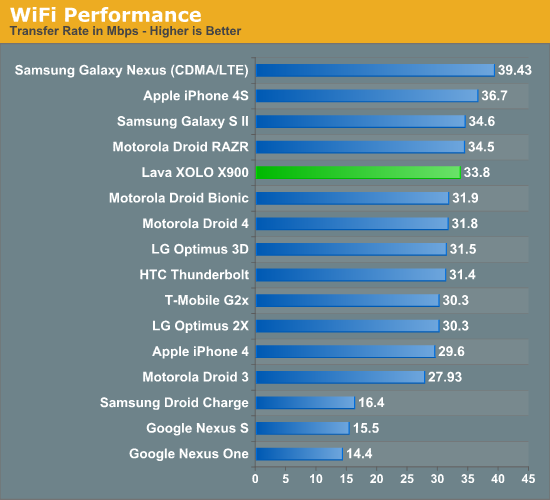
In our WiFi test which consists of a 100 MB PDF loaded over an 802.11n network, the WL1271 does pretty well, just as expected.
GPS
Like the TI WiLink series part, it seems that some Medfield designs include the WiLink 7 series with a GPS basbeand, and others include the more common SiRF Star 4 GSD4t GPS which we have seen in a ton of different smartphones, again including many Samsung phones.

I have no complaints with the GPS lock speed or quality on the X900, it’s speedy and accurate, and works well. I navigated around town with the device and never encountered any problems.
NFC
The X900 also includes NFC support, courtesy the ubiquitous NXP PN544 controller. The smartphone also includes the stock tag reader application, though NFC ships disabled. I tested it on the NFC tag sent with the Nexus S an eternity ago and it worked perfectly.

It’s safe to assume that with the Android 4.0 update beaming will be enabled.
Voice and Speakerphone
The X900 includes some common mode noise suppression components, including a primary and secondary microphone and an Audience eS305 voice processor.
We’ve seen the A102x series in devices before, including the Nexus One, iPhone 4, and numerous other popular smartphones. The reality is that good noise rejection so the far end hears nothing of the ambient sound around you is important both for making calls sound better, and also for increasing the idle or blanking periods on the reverse link. The X900 is my first time hearing the eS305 in action, and to test we did what we normally do by placing a call in front of some speakers, increasing volume, and speaking into the handset while recording the call on the far end on another handset.
I can’t emphasize enough that during the most taxing parts of this recording, I cannot hear myself speak at all. eS305’s performance is great, just like we’ve seen with their other solutions in devices where we’re able to identify its presence. The reality is also that using an array of microphones and some common mode noise rejection is basically the status quo for a high end smartphone right now.
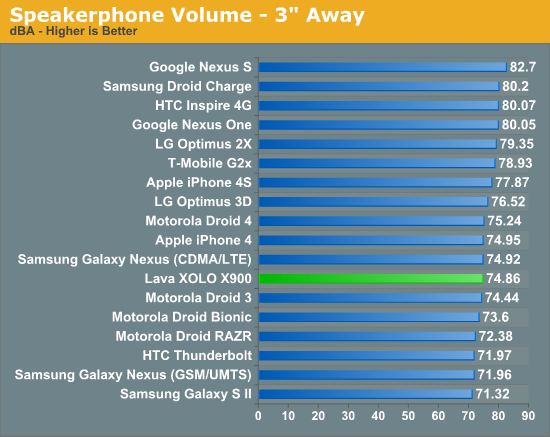
Speakerphone on the X900 is split between the two bottom speaker jacks, and isn't quite as loud as I'd like. We measured as usual with an Extech digital sound data logger 3 inches above the device.


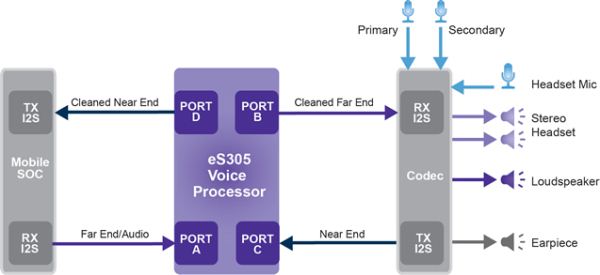








106 Comments
View All Comments
vol7ron - Wednesday, April 25, 2012 - link
I doubt windows would expect PCI channels lol. Though, it might need drivers to operate.Everything you need is on the phone for windows to operate (Screen, CPU, Video, RAM and Disk space) exists, even though Windows doesn't require it all. Though, Windows does need some way to communicate with those devices (device drivers), which Win7/etc probably doesn't have.
Shadowmaster625 - Wednesday, April 25, 2012 - link
A few years from now it is likely I might be able to acquire one of these for dirt cheap. (Broken screen, etc) I would use it just for an ultra low power ultra low profile *single-function* pc. I would very much like to know if this hardware can run windows 7. It doesnt need to run well, it just needs to be able to go on the web and do basic things similar to an atom nettop.superPC - Wednesday, April 25, 2012 - link
it won't run windows 7. unlike windows 8, windows 7 requires standard RAM not LPDDR. windows 7 also requires some form of PCI.Musafir_86 - Wednesday, April 25, 2012 - link
-Excuse me, but IMHO, the type of physical RAM shouldn't matter. If not, we couldn't be able to load these OSes on VMs at all. :)Regards.
B3an - Thursday, April 26, 2012 - link
Why would you even want to run Win 7 on this when Win 8 would clearly be WAY better suited, not to mention it also uses less resources and RAM while remaining faster/snappier than 7.rahvin - Friday, April 27, 2012 - link
I'd imagine he wants to know because Windows 8 is going to be only slightly less successful than Vista. Personally I'd guess around 5% of the Vista sales. It's a disaster in waiting unless they make dramatic last minute changes. You should try using it.joshv - Wednesday, April 25, 2012 - link
I am not sure why this chipset matters. Intel usually wins on x86 compatibility with older software. In the phone space there is no existing x86 code, and in fact they are stuck emulating another ABI - so they will be slower and less efficient that competitors that implement that ABI natively.That leaves Intel to compete on price/performance alone in a market where their competitors have 99.9% of the market. An odd position for Intel.
Perhaps this makes more sense in a Windows 8 tablet?
Impulses - Wednesday, April 25, 2012 - link
Its netbooks all over again, on a much bigger scale. ARM is moving upscale, if Intel doesn't start competing directly they will eventually start ceding some existing market share (when tablets/laptops start to overlap more, and the writing's on the wall with Windows for ARM).Only difference is they're up against a capable rival(s) as opposed to a limping AMD, so they can't just come out of the gate strong and them dog it and let the lower end market stagnate in order to maintain profits.
This is a small first step but it'll allow them to ink more deals and possibly cement a strong foundation for upcoming Win8 ARM tablets which is probably their bigger long term concern.
dcollins - Wednesday, April 25, 2012 - link
Did you even read the article?The x86 vs ARM issue is mostly a non-issue that will be completely resolved within a few months. Dalvik apps are JIT compiled to ARM and x86 and will perform similarly. In fact Intel might have an advantage here because they have the best compiler engineers in the world with decades of experience in generating high performance x86 code. NDK apps will generally be supported natively; developers only have to check a box to include x86 binaries. Even Apps that aren't compiled with x86 support are translated prior to installation on the users device. Nothing about the instruction set makes Medfield slower than ARM.
Performance today is comparable to modern ARM processors even when running an out of date, slower OS. Performance in 4.0.x should match or outperform even Krait. Graphics performance is middle of the road, but that's a major concern for many smartphone buyers (myself included). Even in benchmarks that purposefully stress mutliple cores, Medfield holds its own against the many cored competitors. Real world usage is more lightly threaded.
Browser performance is the most important metric for my usage and here Intel performs extremely well. If Medfield is available in a 4.x phone when it comes time for me to upgrade, I will seriously consider it versus a Krait based offering. Now imagine a next generation Atom build on 22nm with dual core, hyperthreading and possibly OoO execution: that chip will eat A15s for breakfast.
dcollins - Wednesday, April 25, 2012 - link
edit: "Graphics performances... is NOT a major concern"